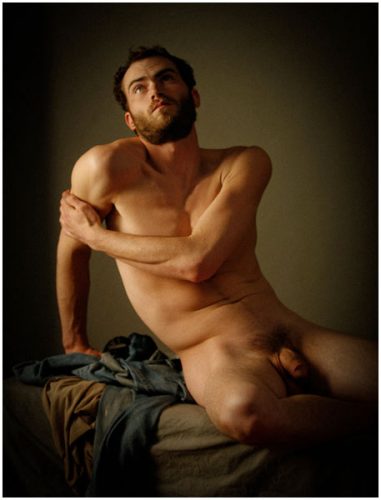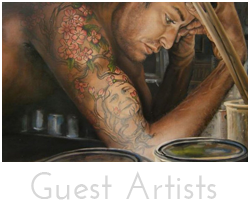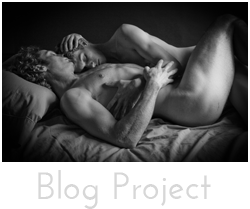 The other day Glenn asked me how does one transfer the light design of one show to another and I began to ramble on for about an hour about how we as designers can create a show and have it remain adaptable yet consistent from venue to venue. But mostly what I went off about was the psychology of light; the impact light has on the performers and the audience. For instance there is a moment in Billy’s show after his partner’s brain begin to malfunction and he loses control of his motor skills and the only way Bill is able to communicate with him is though a series of events which become progressively worse. I designed this sequence where the stage is bright when we begin and as Michael’s tumor becomes worse. I begin to close down and restrict the light on Billy down to a single pure white spot. Billy always likes to run his shows with some of the house lights up on the audience so he can see and interact with them. So as this lighting sequence progresses, even the house lights fade to leave the audience in the dark. I bring this sequence up because it’s the emotional climax of the play and I want to illustrate the psychology of lighting. And this is a great scene because it exists on so many levels. First it mirrors what’s happening within the story of a man dealing with his partner slowing becoming paralyzed and eventually dying of a brain tumor from the late stages of AIDS. As things are taken away from the characters of the story the light also becomes stripped away. The first thing that begins to fade is the color with in the light. Theater lights are colored by thin transparent gels that come in a variety of shades, typically a lighting design will have balance of some warm colors (yellow to reds) and some cool colors (lavenders to blues). These colors are used to control the mood of the play; you can either warm it up or cool it down to match the psychology of what’s happening with the actors within the scene. So the first thing to go in this scene is the color and warmth the stage had been bathed in. The next part is to use the light to represent the presence of Michael, through the light and how he sees Billy. As his brain begins to deteriorate and shut down and become more restrictive so does the light. I keep taking it away very slowly so that the audience is not perceptive of the movement and confinement of the moment. All the while the house lights have also followed this progression of the confinement closing the audience into the darkness. In moments like this it is essential for the audience to have their own privacy to identify with and connect to this grieving process. Often times in moments like this the audience will become so emotionally shaken and overwhelmed that they often cry from the heart break of the emotional journey of the character on stage. Isolating down gives them this privacy in the darkness so they can publicly grieve with the character and this is what makes live theater so interactive.
The other day Glenn asked me how does one transfer the light design of one show to another and I began to ramble on for about an hour about how we as designers can create a show and have it remain adaptable yet consistent from venue to venue. But mostly what I went off about was the psychology of light; the impact light has on the performers and the audience. For instance there is a moment in Billy’s show after his partner’s brain begin to malfunction and he loses control of his motor skills and the only way Bill is able to communicate with him is though a series of events which become progressively worse. I designed this sequence where the stage is bright when we begin and as Michael’s tumor becomes worse. I begin to close down and restrict the light on Billy down to a single pure white spot. Billy always likes to run his shows with some of the house lights up on the audience so he can see and interact with them. So as this lighting sequence progresses, even the house lights fade to leave the audience in the dark. I bring this sequence up because it’s the emotional climax of the play and I want to illustrate the psychology of lighting. And this is a great scene because it exists on so many levels. First it mirrors what’s happening within the story of a man dealing with his partner slowing becoming paralyzed and eventually dying of a brain tumor from the late stages of AIDS. As things are taken away from the characters of the story the light also becomes stripped away. The first thing that begins to fade is the color with in the light. Theater lights are colored by thin transparent gels that come in a variety of shades, typically a lighting design will have balance of some warm colors (yellow to reds) and some cool colors (lavenders to blues). These colors are used to control the mood of the play; you can either warm it up or cool it down to match the psychology of what’s happening with the actors within the scene. So the first thing to go in this scene is the color and warmth the stage had been bathed in. The next part is to use the light to represent the presence of Michael, through the light and how he sees Billy. As his brain begins to deteriorate and shut down and become more restrictive so does the light. I keep taking it away very slowly so that the audience is not perceptive of the movement and confinement of the moment. All the while the house lights have also followed this progression of the confinement closing the audience into the darkness. In moments like this it is essential for the audience to have their own privacy to identify with and connect to this grieving process. Often times in moments like this the audience will become so emotionally shaken and overwhelmed that they often cry from the heart break of the emotional journey of the character on stage. Isolating down gives them this privacy in the darkness so they can publicly grieve with the character and this is what makes live theater so interactive.
I also work with these same theories of lighting psychology in my photography. I began this project telling you that photography is the recording of light on to a plain or medium that can be viewed. Photography began with this theory and has remained consistent throughout this digital recording of images of the present. I tend to like to work in the studio with equipment so that I have full control of what it is I am creating. The quality of this light affects us in so many ways emotionally. First color has a huge impact on how we feel again to simplify, warm to cool. Then it’s the soft or hardness of the light either draws us in or pushes us away. Then you deal with the direction of the light, where does it come from and how does that sculpt the emotional mood of the subject. Lastly you deal with the intensity of the light how much of it do we see, how deep are the shadows. Great painters have been using these theories for centuries and know the power of this in art. This is the beauty of art and what allows an artist to express their thoughts and emotions. Rembrandt was a master of these sorts of portraits. So much of the world takes art for granted, that is just present, when in actuality it is a part of the psychology of those masters perception of the emotional quality of light that always lingers.




>Fascinating! Your writing gets better all the time. Now you can add psychology to your broad base of knowledge. The photo is beautiful and expressive.
Ruth